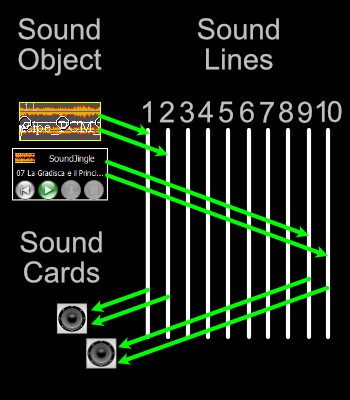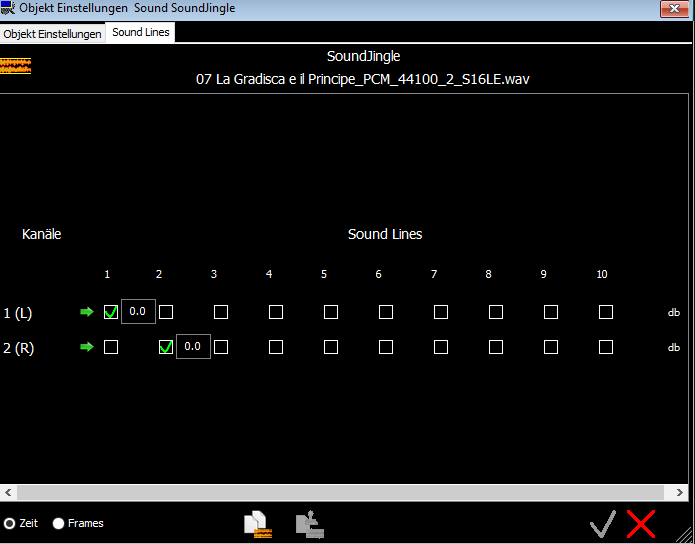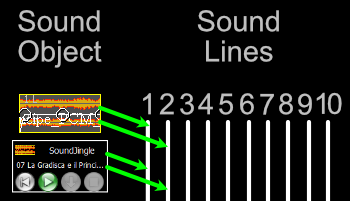Here you set how the channels of a sound object are to be distributed to the sound lines.
These settings are project-dependent and are saved with the project.
Here you set how the sound lines are to be output (distributed to the sound cards).
These settings are independent of the project.
When you exit the liveSHOWsoftware, these settings are saved regardless of the loaded project.
- Click in the menu
 Sound on
Sound on  Sound Card Output.
Sound Card Output.
- A window opens in which all sound cards are listed.

Activate and deactivate a sound card by clicking in the left checkbox of the corresponding sound card.
Note:
Please set the sound cards before starting a project. Activating
another sound card while sound is currently playing may result in sound dropouts or a slight time delay.
The same applies when you connect or disconnect external sound cards (Bluetooth or USB).
- Click on the right icon
 of the corresponding sound card, a window opens with the settings for the sound lines of the sound card.
of the corresponding sound card, a window opens with the settings for the sound lines of the sound card.
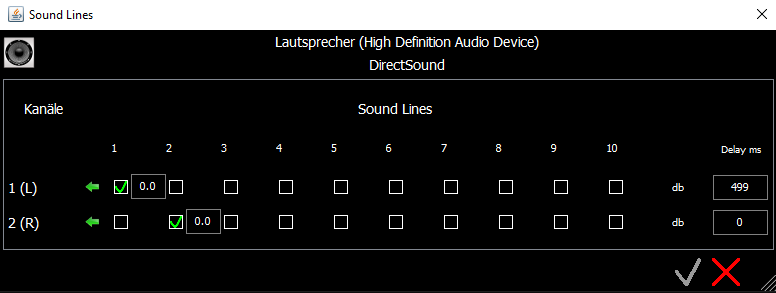
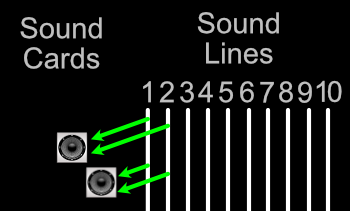
On the left you see the channels of the sound card and on the right the sound lines.
You can assign several sound lines to one channel of a sound card. This is described above in the sound object settings.
- Each output channel of a sound card can be assigned a delay in
milliseconds. Currently, a maximum of 499 ms ( approx. 170m speaker
distance) is possible.

This is helpful in two cases:
- If several sound cards are used and they have latencies between each other.
Here you can assign a delay to all channels of the faster sound card so that the sound cards work in parallel.
- When multiple speakers are used with a large audience:
Here the sound arriving at the rear audience (rear speakers) is slightly delayed from the front speakers.
A delay can be entered in the Delay text box for the channels that are responsible for the front speakers,
so that the sound from the front and rear speakers reaches the rear audience at the same time.
Note: You can also enter the
distance between front and rear speakers in the text field and then
press the 'm' key for meters ('i' = inch, 'f' = foot, 'y' = yard).
The delay in milliseconds is automatically calculated and displayed.
(this is valid for approx. 20 degrees Celsius air temperature).
- Confirm the changes with the green OK button.
 or click on
or click on  to cancel the changes.
to cancel the changes.
Sound cards under Windows and MAC
(the tiresome driver problem)
The MAC usually recognizes multi-channel sound cards and also displays
them with multiple channels. However, not every external sound card is
suitable for the MAC.
Under Windows 10 the sound driver model has changed. In the
liveSHOWsoftware the Microsoft DirectSound API is used, because this is
supported by most multi-channel sound cards (drivers). With the
Microsoft DirectSound sound cards with up to 8 channels (7.1 Sourround
Sound) can be used.
The Windows 10 32bit version is an exception, since the sound output
does not work reliably here. Under Windows 32 bit, all sound cards are
only recognized as stereo sound cards. This should be acceptable, since
32bit computers will probably die out.
Partially sound card drivers represent a multi-channel sound card as
several sound cards with 2 channels each (stereo). Sometimes
multi-channel sound cards are only recognized as stereo sound cards. If
this is the case, one must help oneself at the moment with several
sound cards (these may also be simple sound cards).
Example: The Behringer X Air 18 mixer
has an 18 channel sound card integrated. Under Windows, 8 channels are
detected as 4 sound cards with the old Behringer drivers (Behringer 1 and 2,
Behringer 3 and 4, ....). With the new drivers, only one stereo sound
card (2 channels) is recognized.
Default Settings
Basically, the channels of a
sound object are distributed to the sound lines in order:
(Stereo Sound)
Channel 1: 'Front Left' -> Sound Line 1 (for a single-channel
sound (mono), channel1 is additionally assigned to sound line 2)
Channel 2 'Front Right' -> Sound Line 2
(additional for 5.1 Sound)
Channel 3 'Center' -> Sound Line 3
Channel 4 'Subwoofer -> Sound Line 4
Channel 5 'Rear Left' -> Sound Line 5
Channel 6 'Rear Right' -> Sound Line 6
(additional for 7.1 Sound)
Channel 7 'Alternative Left' -> Sound Line 7
Channel 8 'Alternative Right' -> Sound Line 8
A one channel sound object (mono) is automatically assigned to Sound Line 1 and Sound Line 2.
By default, the sound lines are distributed to the channels of a sound card in order:
(Stereo Sound)
Channel 1: 'Front Left' <- Sound Line 1
Channel 2 'Front Right' <- Sound Line 2
(additional for 5.1 Sound)
Channel 3 'Center' <- Sound Line 3
Channel 4 'Subwoofer <- Sound Line 4
Channel 5 'Rear Left' <- Sound Line 5
Channel 6 'Rear Right' -> Sound Line 6
(additional for 7.1 Sound)
Channel 7 'Alternative Left' <- Sound Line 7
Channel 8 'Alternative Right' <- Sound Line 8
Sound Lines 9 and 10 are not assigned by default.
